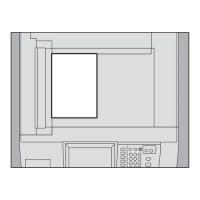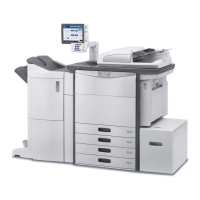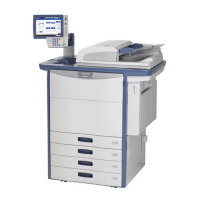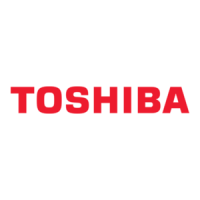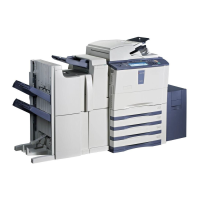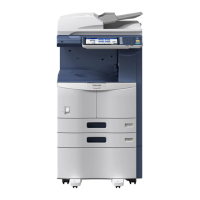e-STUDIO555/655/755/855 © 2009 - 2011 TOSHIBA TEC CORPORATION All rights reserved
FUSER UNIT
13 - 2
13.3 Functions
(1) IH coil (IH-COIL) (IH: Induction heating)
The IH coil is inside the fuser roller and applies the induction heat to the fuser roller. This IH coil
(IH-COIL) is divided into two parts, the center IH coil heating the center of the fuser roller and the
side IH coil heating both ends of the fuser roller. Those parts become ON/OFF separately in
order to maintain the fuser roller at a certain temperature without wasting excessive electric
power.
(2) Fuser roller
The fuser roller is made of iron and induction-heated by an IH coil (IH-COIL). It is pressed by the
pressure roller, which is mentioned below, and the toner is fused on the paper while the paper is
passing between these two rollers with the toner image on the paper facing the fuser roller. So,
the toner is made to soak into the fibers of the paper by being melted with the heat of the fuser
roller and having heat conductivity improved due to pressure from the pressure roller.
The surface of the fuser roller is coated with fluoroplastic to prevent the toner adhering to it (this
is called "offset") and help it become separated from the roller.
(3) Pressure roller
The pressure roller is made of rubber (PFA tube roller) to make it easier to press against the
fuser roller and its pressure is always derived from a spring force.
(4) Separation fingers
The separation fingers are for removing paper that has stuck to the fuser and pressure rollers.
(5) Cleaning web
The cleaning web is attached touching the fuser roller by means of the web pushing roller to
remove any toner or paper dust that has stuck to the fuser roller during the fusing process. It is
rolled up by the web motor (M4) with its clean surface always touching the fuser roller. It also
contains silicone oil for coating the surface of the fuser roller, which makes it easier to clean up
any toner or paper dust.
The cleaning web rolled around the roller has been made thinner and lengthened. This has
increased the web rolling up speed and improved the cleaning performance. The cleaning web's
cleaning performance is the same as that of the cleaning roller, so this equipment does not have
a cleaning roller.
(6) Fuser exit roller
The fuser exit roller transports the paper separated from the fuser and pressure rollers with the
separation fingers through the fuser unit.
(7) Fuser transport sensor (S9)
This sensor is for detecting that the trailing edge of the paper has reached the fuser unit exit
sensor and also for the detecting of paper jams at the fuser unit exit section.
(8) Fuser roller center thermistor (THM2) and Fuser roller rear thermistor (THM3)
These thermistors (THM2 and 3) detect the temperature of the fuser roller to maintain it within a
certain range, which is higher than the lower limit which would cause poor fusing and lower than
the upper limit which would cause a high temperature offset. When the temperature of the fuser
roller is lower than the preset temperature, it is turned ON to supply power to the IH coil (IH-
COIL), and when it is higher than the preset temperature, it is turned OFF to cut the supply. It
also detects the slight difference of the temperatures at the center and rear end of the fuser roller
to control the ON/OFF of the center and side IH coil to keep the fuser roller at a certain
temperature.
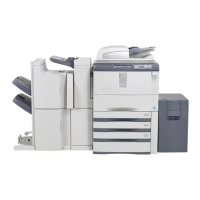
